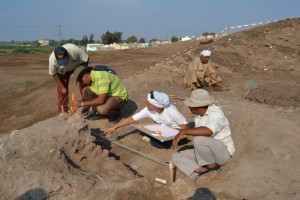
Courtesy of Dr Gasperini
In Behira, a team of Italian archeologists are hard at work on reconstructing and documenting the history of a forgotten site, Kom Al-Ahmer. Little is known about the work on site, so we spoke with Dr Valentina Gasperini, co-director of the archaeological mission, along with Professor E. Papi and Dr Mohamed Kenawi.
Dr Gasperini explained the history of research on the site: “In 1935, Adriani visited the site and collected some finds, among them a head in marble, but left without excavating. In the 1940s, El-Khashab conducted the first and the only archaeological excavation on the site and discovered two great baths.
However, because El-Khashab did not find any written records mentioning the ancient name of the site, he dismissed the notion that they might be part of a town.
He suggested that there was a town close by and that the bath complex at Kom Al-Ahmer was a service area for that town. P. Wilson visited the site in 2004; M. De Vos and Mohamed Kenawi visited in February 2008. Between 2009 and 2011, the site was surveyed as part of the Western Rosetta Branch Documentation Project from the Università Degli Studi di Trento and the Università Degli Studi di Siena.”
Past Egyptian missions by El-Khashab were successful in documenting some objects at the site: “Tens of coins were found, the oldest dating to Ptolemy III and the most recent being a gold dinar struck in the Islamic year 154 / C.E. 771.”
The mission did extensive research before commencing excavation. “We first studied the old excavation publications and then searched in all Greek, Latin, Coptic and Arabic sources that wrote about the area of the Delta; we decided to work on site to understand the origin and the end, we needed to know when life started and when the site was abandoned and why. The site is located near Mahmoudia in Beheira, and it is located six kilometres west of the Rosetta branch. We started [the mission] in September 2012 and we should continue working for the next seven to ten years,” said Dr Kenawi.
The project is conducted under the auspices of the University of Siena in Italy and the Supreme Council of Antiquities. The aim of the mission is mainly to document. “The mission works to document the site and to re-construct the urban system during the Hellenistic Roman period. We think that the site might have hosted the ancient capital Metelis,” said Dr Kenawi, who stresses the fact that the location of Metelis is not confirmed and it is currently just a theory.
The mission has already documented some findings: “This year we have excavated an area of 10 x 10m, where the foundation of a large structure was discovered; thousands of pottery shards were studied and later gave us the date of the excavated area. The date, which is the most important thing for us, lies between the 4th and the 8th century C.E. according to the study of pottery shards.
The amphora finds confirm a strong commercial relation between Egypt (and in this case the Western Delta), and the Eastern Mediterranean between the 4th and 8th century C.E. where products like olive oil, wine and grain were imported and exported. ”
The mission is also hoping to offer some new research concerning the use of “non-destructive techniques, which were previously used in Italy, Greece and other Mediterranean countries. In addition to conducting a geo-archaeological study and topographic survey of the site and surrounding landscape, collecting all written materials, photos, maps of the site, we will create a photo mosaic of all the remains and finally conduct a detailed structural survey of the site,” explained DrGasperini.
Dr Gasperini mentioned that working in this location is specifically important because there are few missions in the Delta and the main benefit of the Kom Ahmer archeological mission is to preserve the history of this location.
The Italian mission works together with many Egyptian partners, trying to increase local farmers’ understanding of the archaeological importance of the site so that they can protect the site themselves.




